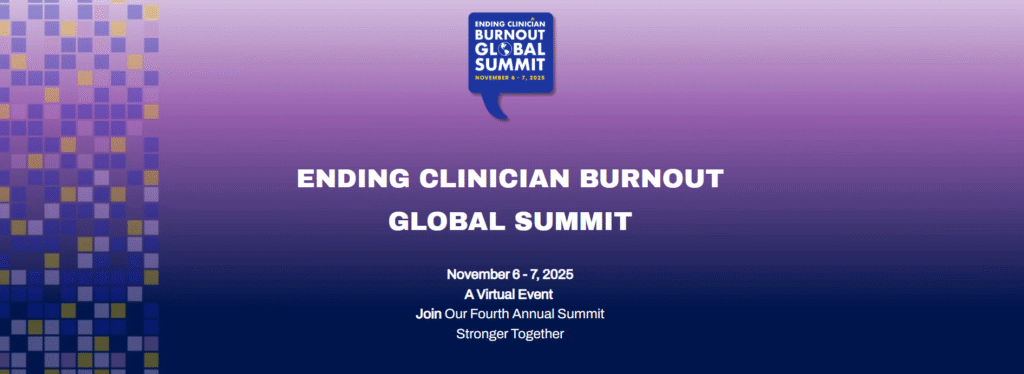Best Sleep Aids For Night Shift Workers: What Actually Works?
Discover evidence-based solutions for better daytime sleep quality after night shifts. Learn about the unique challenges night shift workers face, and explore effective strategies such as creating optimal sleep environments, using light-blocking solutions, sound management strategies, temperature control, natural sleep aids, pharmaceutical options, sleep tracking technology, pre-sleep routines, and how NightOwling can help improve your…
![Photo of [object Object] in undefined](https://nightowling.com/wp-content/uploads/2025/10/image-261.png)
If you work the night shift, you know the struggle all too well: trying to sleep while the rest of the world is wide awake, with sunlight streaming through your windows and the sounds of daily life creating a constant backdrop of disruption.
And let’s be honest-for many night shift workers, quality sleep isn’t just elusive; it feels downright impossible at times.
The consequences of poor sleep go beyond feeling tired. Research consistently shows that chronic sleep deprivation among night shift workers contributes to increased accident risk, compromised immune function, and higher rates of serious health conditions like diabetes, heart disease, and depression.
But here’s the good news: with the right sleep aids and strategies, you can dramatically improve both the quantity and quality of your daytime sleep. In this comprehensive guide, I’ll cut through the marketing hype to share what actually works, based on both scientific research and real-world experience from night shift workers.
Whether you’ve been working nights for years or are just making the transition, these evidence-based approaches can help you get the restorative sleep you need to protect your health and perform at your best.
Jump to a specific section in this article ↓↓
- Why night shift workers face unique sleep challenges
- Creating the optimal sleep environment for daytime rest
- Light-blocking solutions that actually work
- Sound management strategies for uninterrupted sleep
- Temperature control for better daytime sleep
- Natural sleep aids with proven effectiveness
- Pharmaceutical options: when and how to use them safely
- Sleep tracking and improvement technology
- Pre-sleep routines that signal rest to your body
- How NightOwling can help improve your sleep
- All of the FAQs in this article
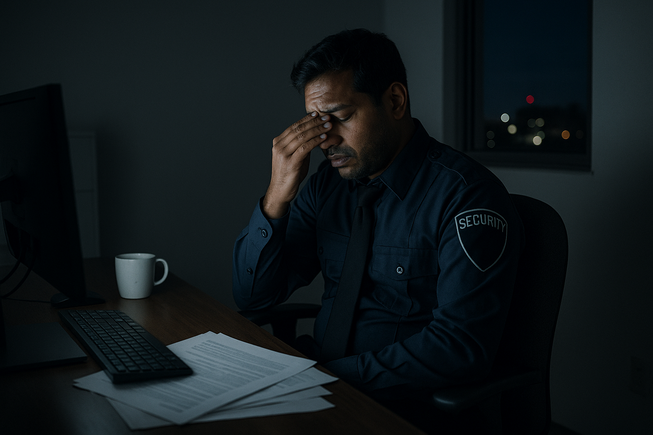
Why night shift workers face unique sleep challenges
Before diving into solutions, it’s important to understand why sleeping during the day is fundamentally different from sleeping at night-even beyond the obvious environmental differences.
The circadian mismatch
Your body has an internal clock-your circadian rhythm-that regulates countless biological functions, including your sleep-wake cycle. This system evolved to align with natural light patterns, promoting wakefulness during daylight and sleep during darkness.
When you work overnight, you’re asking your body to do the exact opposite of what it’s biologically programmed to do. This circadian disruption affects far more than just your sleep; it impacts hormone production, metabolism, digestion, and cognitive function.
The primary sleep hormone, melatonin, is naturally suppressed by light exposure. During day sleep attempts, your body receives conflicting signals: the presence of light tells it to stay awake, while your exhaustion from working all night signals the need for sleep.
The environmental hurdles
Beyond the biological challenges, night shift workers contend with practical obstacles to quality sleep:
- Environmental light from windows and electronic devices can suppress melatonin production, making it harder to fall and stay asleep.
- Daytime noise from traffic, construction, neighbors, and even family members can disrupt sleep stages and prevent deep, restorative sleep.
- Higher daytime temperatures run counter to your body’s need for cooler conditions during sleep, further complicating daytime rest.
- Social obligations and family responsibilities often occur during your sleep hours, forcing difficult choices between rest and relationships.
These combined factors make quality sleep particularly challenging for night shift workers. However, targeted sleep aids and strategies can help address each of these obstacles.
For more detailed information about how night work affects your circadian rhythm, check out NightOwling’s resources on sleep science.
↑↑ Back to the list at the top ↑↑
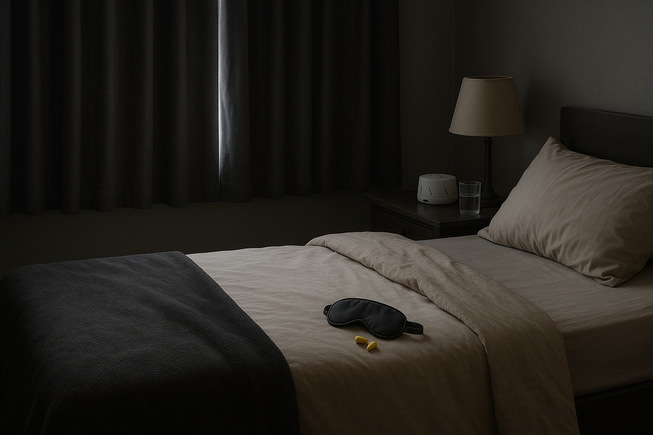
Creating the optimal sleep environment for daytime rest
The foundation of good sleep-regardless of timing-is your sleep environment. For night shift workers, this becomes even more critical since you’re working against natural light and sound patterns.
The science of sleep environments
Research consistently shows that three environmental factors most strongly impact sleep quality: light, sound, and temperature. Optimizing these elements creates a sleep sanctuary that can dramatically improve your rest despite the challenges of daytime sleeping.
Bedroom setup for night workers
Start by designating your bedroom (or sleep space) as a dedicated sleep zone. This means:
- Removing work materials, exercise equipment, and other non-sleep items that can create mental associations with wakefulness.
- Positioning your bed away from windows if possible to minimize light exposure.
- Ensuring your mattress and pillows properly support your preferred sleep position. Side sleepers, back sleepers, and stomach sleepers have different support needs, and addressing these can improve sleep quality regardless of timing.
- Installing air circulation systems like ceiling fans or portable fans to maintain air movement and optimal temperature.
- Creating storage solutions for sleep aids so they’re always ready and accessible when you need them.
Think of your sleep environment as a complete system rather than a collection of individual products. Each element should work together to create conditions that signal to your body that it’s time to sleep, despite external cues suggesting otherwise.
For a comprehensive sleep environment assessment specifically designed for night shift workers, visit NightOwling’s expert resources.
↑↑ Back to the list at the top ↑↑
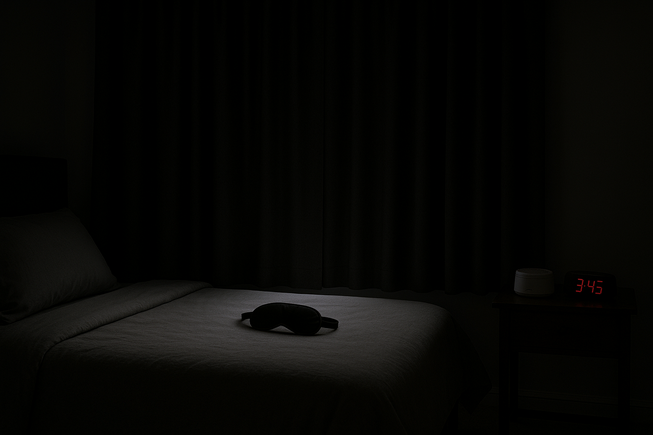
Light-blocking solutions that actually work
Light is the most powerful external regulator of your sleep-wake cycle. Effectively managing light exposure-both before and during sleep-is perhaps the most important factor for successful daytime sleep.
Blackout window treatments
Not all “blackout” solutions are created equal. For true light elimination:
- Blackout curtains should extend beyond the window frame on all sides and be made with multiple layers of light-blocking fabric. Look for options with thermal properties that also help with temperature and sound control.
- Window films applied directly to the glass provide another layer of light blocking. These semi-permanent solutions are particularly useful for renters who can’t make major modifications.
- Blackout blinds mounted inside the window frame can be combined with curtains for maximum light blocking. Cellular or honeycomb designs also provide thermal benefits.
- Window covers with magnetic or velcro edges create a complete seal around windows, eliminating the light that often leaks around the edges of standard curtains. These are especially effective for shift workers who need absolute darkness.
Personal light blocking
Even with excellent window treatments, personal light blocking can provide an additional layer of protection:
- Sleep masks should contour to your face without putting pressure on your eyes. Look for designs with adjustable straps, breathable materials, and complete coverage around the nose area where light often leaks in.
- Specialty masks with features like cooling inserts, weighted elements, or built-in sound blocking can address multiple sleep challenges simultaneously.
- Light-blocking head covers or sleep hoods provide comprehensive coverage for those extremely sensitive to light. While they may look unusual, many night shift workers find them more effective than traditional sleep masks.
Electronic light management
Electronic devices emit blue wavelength light that is particularly disruptive to melatonin production:
- Blue light blocking apps for phones, tablets, and computers should be activated during the hours before sleep. Most devices now have built-in “night mode” settings, but dedicated apps often provide more complete protection.
- Blue light blocking screen protectors provide physical filtration of blue wavelengths for devices you use before sleep.
- Smart home systems can be programmed to automatically adjust lighting throughout your home based on your sleep-wake schedule, gradually dimming lights before sleep and maintaining dark or red-wavelength lighting during your sleep hours.
For personalized light management recommendations based on your specific living situation and sensitivity, NightOwling offers customized assessment tools designed specifically for night shift workers.
↑↑ Back to the list at the top ↑↑
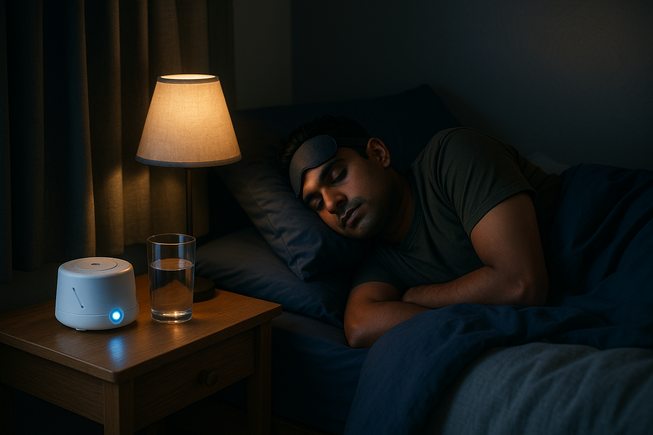
Sound management strategies for uninterrupted sleep
Environmental noise poses a significant challenge for daytime sleepers. Effective sound management involves both blocking external noise and creating a consistent sound environment that masks unpredictable disruptions.
Sound blocking approaches
Physical sound blocking creates the first line of defense against environmental noise:
- Earplugs come in various materials and noise reduction ratings (NRR). Foam options are inexpensive but compress with repeated use, while silicone and wax alternatives provide better sealing and comfort for side sleepers. Custom-molded earplugs offer the highest level of noise reduction and comfort but at a higher price point.
- Sound-reducing curtains with multiple layers of dense fabric can reduce ambient noise by 25-40%. These are particularly effective when combined with blackout properties.
- Door sweeps and weatherstripping minimize sound transmission through gaps around doors. These inexpensive additions can significantly reduce household noise infiltration.
- Acoustic panels strategically placed on walls shared with noisy areas can absorb sound vibrations before they reach your sleeping space. Modern designs are decorative as well as functional.
Sound masking technology
Creating a consistent sound backdrop masks unpredictable noises that might otherwise wake you:
- White noise machines generate consistent sound across all frequencies. Look for models with adjustable volume, multiple sound options, and programmable timers.
- Pink and brown noise generators produce sound weighted toward lower frequencies, which many people find more soothing than traditional white noise. These can be especially effective at masking low-frequency neighborhood sounds like traffic or construction.
- Natural sound machines with options like rainfall, ocean waves, or fan sounds provide a more varied but still consistent audio backdrop.
- Sound masking apps allow you to customize your sound environment, combining different elements to create the most effective masking for your specific noise challenges.
Communication strategies
Managing human-generated noise requires clear communication:
- “Day sleeper” door signs with specific sleep hours listed educate delivery personnel, neighbors, and visitors about your schedule.
- Family sound agreements establishing quiet zones and times help household members understand and respect your sleep needs. These are especially important for night workers with children.
- Noise notification systems like modified doorbells or smart home integrations can route notifications to family members who are awake rather than disrupting your sleep.
For comprehensive sound management recommendations based on your specific living situation, explore NightOwling’s sleep environment assessment tools.
↑↑ Back to the list at the top ↑↑
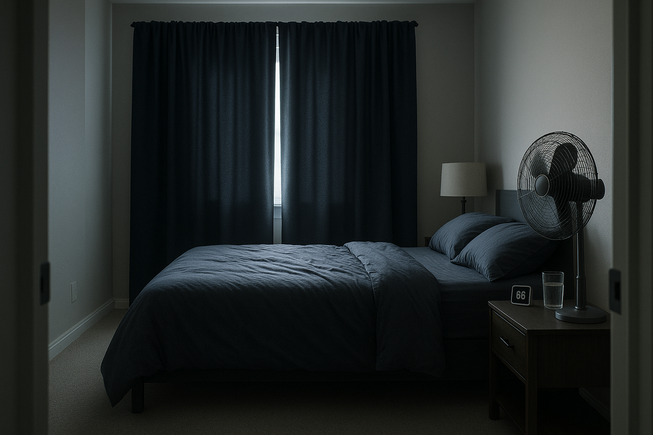
Temperature control for better daytime sleep
Your body temperature naturally drops during sleep. Supporting this process by creating a cool sleep environment significantly improves sleep quality. However, daytime temperatures are typically higher than nighttime, creating another challenge for night shift workers.
Optimal sleep temperature
Research consistently shows that ambient temperatures between 60-67°F (15-19°C) provide the best conditions for quality sleep. During daylight hours, maintaining this range often requires active cooling strategies.
Cooling your sleep space
Creating and maintaining cool sleeping conditions during the day might require:
- Programmable thermostats that automatically lower your home’s temperature during your planned sleep hours can maintain optimal conditions without requiring manual adjustments.
- Zone-based cooling systems that prioritize your bedroom over other areas of the home can provide targeted temperature control while minimizing energy costs.
- Portable air conditioners or cooling fans designated specifically for your sleep space provide focused cooling without affecting the entire home’s temperature.
- Ceiling fans create air movement that enhances the cooling effect, making even slightly higher room temperatures more comfortable for sleep.
Cooling your body
Beyond ambient room temperature, products that directly cool your body can further enhance sleep quality:
- Cooling mattress toppers with gel-infused memory foam, natural latex, or phase-change materials pull heat away from your body during sleep. Some advanced options use circulating water systems for precise temperature control.
- Cooling pillows maintain a lower temperature for your head and neck, areas particularly sensitive to heat during sleep.
- Breathable, moisture-wicking bedding made from bamboo, Tencel, or specialized cooling fabrics allows better airflow and prevents the heat buildup common with standard cotton sheets.
- Bed fans that direct airflow between sheets can dramatically improve comfort during warmer months when maintaining ideal room temperature is challenging.
Seasonal adjustments
Temperature management strategies should adapt to seasonal changes:
- Summer daytime sleep may require multiple cooling approaches used simultaneously, particularly in warmer climates. Combining room air conditioning with personal cooling products often provides the best results.
- Winter daytime sleep generally requires less active cooling, but overheating can still occur due to heating systems designed for daytime comfort. Separating your bedroom temperature control from the rest of your home becomes particularly valuable.
For personalized temperature management recommendations based on your climate, home setup, and personal preferences, visit NightOwling for customized guidance.
↑↑ Back to the list at the top ↑↑
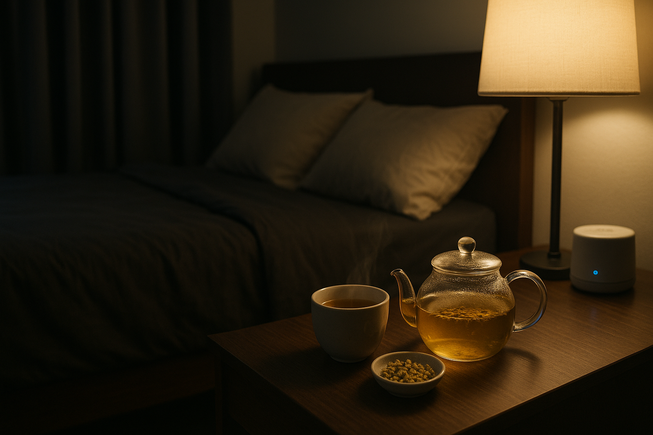
Natural sleep aids with proven effectiveness
Many night shift workers prefer to start with natural approaches to improving sleep. Several evidence-based options have demonstrated real benefits for daytime sleepers.
Melatonin: proper usage for shift workers
Melatonin is perhaps the most researched sleep aid for night shift workers, but proper usage is critical:
- Timing matters most. Take melatonin 30-60 minutes before your planned sleep time, regardless of when that occurs during the day.
- Dosage should start low. Begin with 0.5-3mg and increase gradually only if needed. Higher doses don’t necessarily work better and may cause side effects like headaches or vivid dreams.
- Extended-release formulations may be more effective for maintaining sleep throughout the day, while standard formulations help more with sleep onset.
- Consistency is key. Melatonin works best when used as part of a regular sleep schedule rather than occasionally.
Herbal supplements with research support
Several herbal supplements show promise for improving sleep quality:
- Valerian root has moderate evidence supporting its effectiveness for sleep onset and quality. Look for standardized extracts and follow package dosing instructions.
- Lemon balm, particularly when combined with valerian, may improve sleep quality and reduce sleep disturbances. Tea forms are widely available and well-tolerated.
- Lavender, either as an essential oil for aromatherapy or in standardized oral supplements, has demonstrated benefits for sleep quality and anxiety reduction.
- L-theanine, an amino acid found naturally in tea, promotes relaxation without sedation and may help with the transition to sleep after stimulating night shifts.
Nutritional approaches to better sleep
Certain foods and nutrients can support healthier sleep patterns:
- Tryptophan-rich foods like turkey, milk, bananas, and nuts provide the amino acid precursor to serotonin and melatonin.
- Magnesium-rich options such as dark leafy greens, nuts, seeds, and whole grains support muscle relaxation and nervous system regulation. Magnesium supplements are also widely used, with glycinate forms being particularly well-absorbed.
- Tart cherry juice is one of the few food sources of natural melatonin and has research supporting its sleep-promoting effects when consumed before bedtime.
- Chamomile tea contains apigenin, which binds to benzodiazepine receptors in the brain and may promote relaxation and sleepiness.
For detailed guidance on natural sleep aids appropriate for your specific situation, check out NightOwling’s expert resources designed specifically for night shift workers.
↑↑ Back to the list at the top ↑↑

Pharmaceutical options: when and how to use them safely
While natural approaches work for many, some night shift workers may need prescription sleep aids, especially during adaptation periods or for occasional use during difficult sleep transitions.
When to consider prescription options
Prescription sleep aids are typically recommended when:
- Natural approaches have been ineffective despite consistent, proper implementation.
- Sleep difficulties are severely impacting health, safety, or quality of life.
- Temporary assistance is needed during schedule transitions or particularly challenging periods.
- A medical professional has evaluated your specific situation and determined that benefits outweigh potential risks.
Types of prescription sleep aids
Different medications work through different mechanisms:
- Non-benzodiazepine receptor agonists (Z-drugs) like zolpidem, eszopiclone, and zaleplon have fewer side effects than older options but still require careful use.
- Orexin receptor antagonists work differently from traditional sleep medications by blocking wake-promoting signals rather than directly inducing sleep.
- Sedating antidepressants are sometimes prescribed at low doses specifically for their sleep-promoting effects rather than for depression.
- Anti-histamines with sedating properties are occasionally prescribed but may cause daytime grogginess that can be problematic for night shift workers.
Safety considerations
All prescription sleep medications come with important considerations:
- Tolerance and dependence can develop with regular use of many sleep medications, particularly benzodiazepines.
- Next-day impairment including decreased alertness and reaction time can affect safety during your subsequent night shift.
- Interaction with other medications or substances must be evaluated by healthcare providers.
- Sleep quality differences from natural sleep should be understood-many medications change sleep architecture, reducing certain sleep stages.
If considering prescription options, work with a healthcare provider who understands shift work and can help you weigh the benefits and risks for your specific situation.
↑↑ Back to the list at the top ↑↑
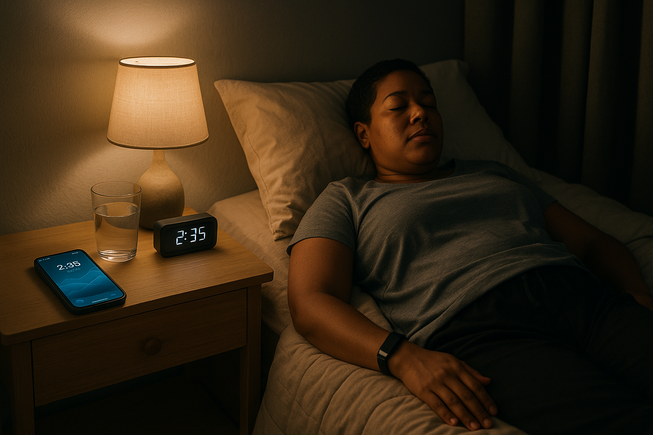
Sleep tracking and improvement technology
Technology can provide valuable insights into your sleep patterns and help identify effective improvement strategies specific to your situation.
Sleep tracking options
Various technologies can monitor different aspects of your sleep:
- Wearable devices like fitness trackers and smartwatches monitor movement patterns and sometimes heart rate variability to estimate sleep stages and duration.
- Bed sensors placed under your mattress or fitted sheet track movement, heart rate, and breathing without requiring you to wear anything during sleep.
- EEG headbands measure brain wave activity for more accurate sleep stage tracking, though they’re typically more expensive than other options.
- Smartphone apps use your phone’s accelerometer to track movement during sleep when placed on your mattress, providing a low-cost entry point to sleep tracking.
Interpreting sleep data
Raw data becomes valuable when you understand what to look for:
- Sleep efficiency (percentage of time in bed actually spent sleeping) provides insight into how well your sleep aids and environment are working.
- Sleep latency (how long it takes to fall asleep) helps evaluate whether your pre-sleep routine and initial sleep aids are effective.
- Sleep stage distribution shows whether you’re achieving adequate deep and REM sleep, the most restorative stages.
- Consistency patterns across days reveal how well your circadian rhythm is adapting to your shift schedule.
Smart home integration for sleep
Connected home technology can support better sleep environments:
- Automated blackout systems that deploy on schedules aligned with your sleep timing.
- Smart lighting that adjusts color temperature based on your ideal circadian patterns rather than standard day-night cycles.
- Programmable climate control that creates ideal sleeping temperatures precisely when needed.
- Connected sound management that automatically activates white noise or sound masking when you’re preparing for sleep.
For guidance on selecting and interpreting sleep tracking technology specific to night shift patterns, explore NightOwling’s technology recommendations.
↑↑ Back to the list at the top ↑↑

Pre-sleep routines that signal rest to your body
Perhaps the most underutilized yet powerful sleep aid is a consistent routine that prepares your body and mind for rest, regardless of what time of day it occurs.
The science of sleep transitions
Your brain relies on consistent cues to prepare for sleep. For night shift workers, these cues become even more important since you’re asking your body to sleep when environmental signals suggest wakefulness.
A well-designed pre-sleep routine creates a buffer zone between work and rest, allowing your mind to process the day’s events and your body to begin physiological preparation for sleep.
Designing an effective wind-down sequence
An effective pre-sleep routine typically includes:
- Consistent timing and sequence that creates predictable patterns your brain learns to associate with upcoming sleep.
- Gradual light reduction starting 30-60 minutes before planned sleep, including blue light blocking glasses if you must use screens.
- Temperature management like a warm shower followed by entering a cool bedroom, which mimics the natural evening drop in body temperature that signals sleep.
- Gentle stretching or relaxation exercises that release physical tension accumulated during your shift.
- Mindfulness practices such as meditation, deep breathing exercises, or body scans that quiet mental activity.
- Sleep-supporting beverages like chamomile tea or tart cherry juice consumed as part of your wind-down ritual.
Making it sustainable
The best pre-sleep routine is one you can maintain consistently:
- Keep it reasonable in length (30-60 minutes is typically sufficient).
- Include activities you genuinely enjoy so the routine feels rewarding rather than burdensome.
- Have alternate versions for days when time is limited, ensuring you maintain core elements even when abbreviated.
- Track the effectiveness of different components and adapt based on what works best for your specific needs.
For step-by-step guidance in building a pre-sleep routine specifically designed for night shift patterns, check out NightOwling’s guided journeys.
↑↑ Back to the list at the top ↑↑
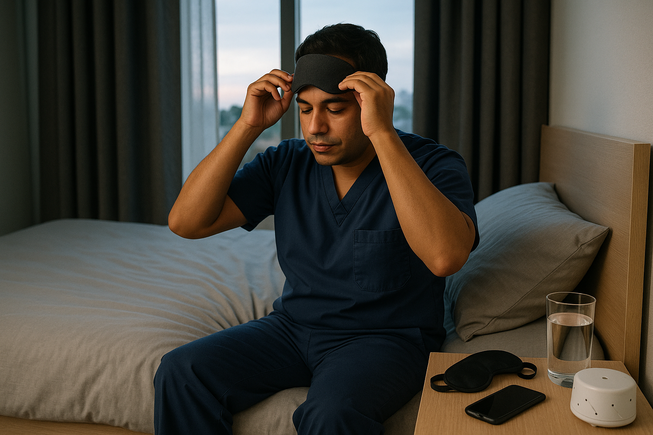
How NightOwling can help improve your sleep
Managing sleep as a night shift worker doesn’t have to be a solitary journey. NightOwling was created specifically to support the unique needs of people working unconventional hours.
Personalized sleep assessment and recommendations
Night shift sleep challenges vary based on your specific work pattern, home environment, chronotype, and health status. NightOwling provides:
- Customized sleep aid recommendations based on your particular challenges and preferences.
- Sleep environment assessments that identify specific improvements for your sleeping space.
- Shift adaptation plans tailored to your specific schedule.
Expert-developed resources
NightOwling’s resources are developed by specialists in sleep medicine, chronobiology, and occupational health:
- Video tutorials demonstrating optimal use of various sleep aids ensure you get the maximum benefit.
- Printable guides and checklists help you implement comprehensive sleep hygiene practices.
- Research updates keep you informed about the latest findings relevant to night shift sleep.
Ongoing support and tracking
Improving sleep is an evolving process that benefits from continued adjustments:
- Sleep tracking tools specific to irregular schedules help you identify what’s working and what needs modification.
- Progress monitoring provides motivation as you see tangible improvements in your sleep metrics.
- Access to specialists who understand the unique challenges of night shift sleep provides personalized guidance when needed.
By leveraging these specialized resources, you can develop a comprehensive approach to sleep that works with, rather than against, your night shift lifestyle.
↑↑ Back to the list at the top ↑↑
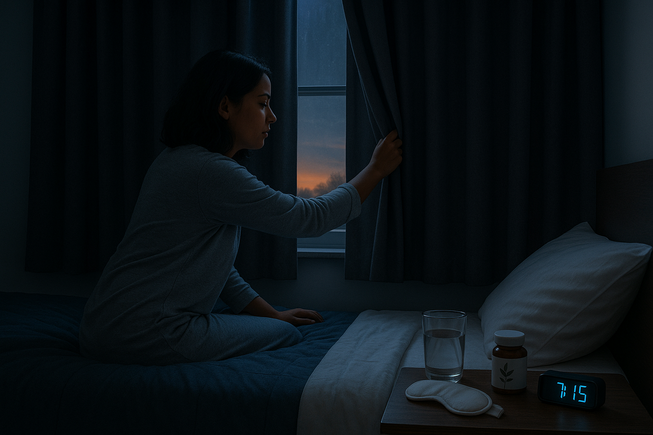
All of the FAQs in this article: Best Sleep Aids for Night Shift Workers
What is the single most effective sleep aid for night shift workers?
While individual responses vary, blackout solutions combined with strategic melatonin use consistently show the strongest evidence for improving daytime sleep. Complete darkness signals your brain to produce natural melatonin, while supplemental melatonin (0.5-3mg taken 30-60 minutes before sleep) reinforces this signal. This combination addresses the fundamental circadian disruption that makes daytime sleep challenging.
How can I fall asleep faster after a night shift?
Develop a consistent pre-sleep routine that includes: wearing blue-light blocking glasses during your commute home, taking a warm shower followed by entering a cool bedroom, practicing 5-10 minutes of deep breathing or progressive muscle relaxation, and ensuring your bedroom is completely dark and quiet. This combination of light management, temperature regulation, and relaxation techniques helps override your body’s natural daytime alertness.
Are sleeping pills safe for night shift workers?
Prescription sleep medications can be appropriate for temporary use during adaptation periods or occasional difficult sleep transitions, but they’re not recommended for long-term daily use due to potential tolerance, dependence, and side effects that may impact subsequent shift alertness. Always work with a healthcare provider who understands shift work to evaluate whether benefits outweigh risks for your specific situation.
What’s the best sleep mask for daytime sleeping?
Look for a mask with contoured eye cups that prevent pressure on your eyelids, an adjustable strap that doesn’t slip, complete coverage around the nose area where light often leaks in, and breathable materials. Memory foam options with cooling properties are particularly effective for daytime sleep when temperatures are naturally higher. Test different styles to find what works with your preferred sleep position.
Should night shift workers use melatonin every day?
For established night shift workers with consistent schedules, regular melatonin use (0.5-3mg taken 30-60 minutes before planned sleep) can be appropriate when used as part of a comprehensive sleep strategy. Those with rotating shifts should be more cautious with regular use, as timing becomes more complex. Start with the lowest effective dose and consult a healthcare provider for personalized guidance, especially for long-term use.

![Photo of [object Object] in undefined](https://nightowling.com/wp-content/uploads/2025/11/image-17.png)
